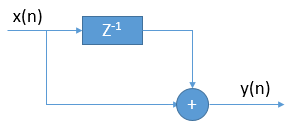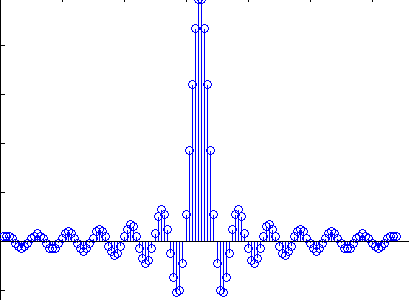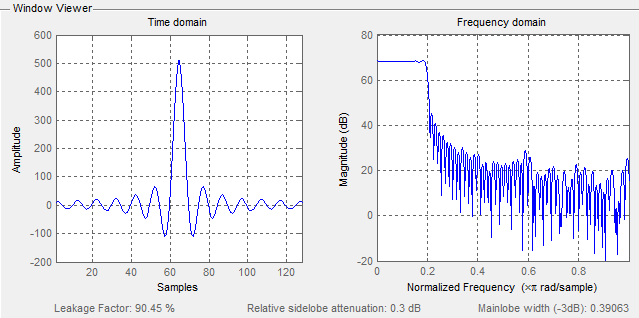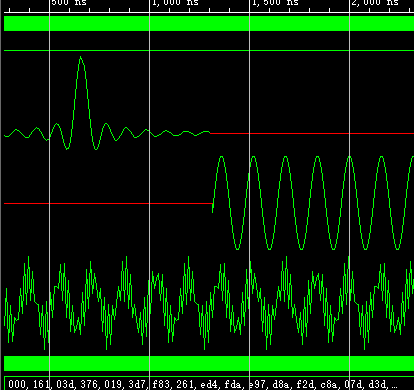FIR仿真module_04
作者:桂。
时间:2018-02-06 12:10:14
链接:http://www.cnblogs.com/xingshansi/p/8421001.html
前言
本文主要记录基本的FIR实现,以及相关的知识点。
一、基本型实现
首先从最基本的FIR入手:

对应module:
`default_nettype none
//
module smplfir(i_clk, i_ce, i_val, o_val);
parameter IW=15;
localparam OW=IW+1;
input wire i_clk, i_ce;
input wire [(IW-1):0] i_val;
output reg [(OW-1):0] o_val; reg [(IW-1):0] delayed; initial delayed = 0;
always @(posedge i_clk)
if (i_ce)
delayed <= i_val; always @(posedge i_clk)
if (i_ce)
o_val <= i_val + delayed; endmodule
二、通用版FIR
前文里最多涉及阶数为5的FIR,这里给出适用任意阶、给定位宽的FIR。
A-参数转化
vivado仿真用到浮点->定点,需要将给定数据转为定点补码、或通过补码读取数据。
1)浮点转定点补码:
clc;clear all;close all;
%=============产生输入信号==============%
N=12; %数据位宽
load fir128.mat;
y_n = fir128;
y_n=round(y_n*(2^(N-3)-1)); %N比特量化;如果有n个信号相加,则设置(N-n)
%=============设置系统参数==============%
L=length(y_n); %数据长度
%=================画图==================%
stem(1:L,y_n);
%=============写入外部文件==============%
fid=fopen('win.txt','w'); %把数据写入sin_data.txt文件中,如果没有就创建该文件
for k=1:length(y_n)
B_s=dec2bin(y_n(k)+((y_n(k))<0)*2^N,N);
for j=1:N
if B_s(j)=='1'
tb=1;
else
tb=0;
end
fprintf(fid,'%d',tb);
end
fprintf(fid,'\r\n');
end fprintf(fid,';');
fclose(fid);
原型滤波器fir128为128阶的FIR滤波器。

生成的txt调用:$readmemb("*.txt",data);
2)给定补码,读取原数据:
clc;clear all;close all;
filename = 'win.txt';
fid = fopen(filename);
data_cell = textscan(fid,'%s','HeaderLines',0);
data = data_cell{1,1}; Nbit = 12;%number of bits
len = length(data)-1;%length of filter
wins = zeros(1,len);
for i = 1:len
str_win = data{i};
if (str_win(1) == '0')
wins(i) = bin2dec(str_win(2:end));
end
if (str_win(1) == '1')
wins(i) = -bin2dec(num2str(ones(1,Nbit-1)))+bin2dec(str_win(2:end));
end
end
wvtool(wins)
得到滤波器特性如下图所示,当然也可以hex2dec转为16进制,思路一致。

B-仿真模型
testbench:
`timescale 1ns / 1ps
module tb;
// Inputs
reg Clk;
reg rst;
// Outputs
parameter datawidth = 12;
wire signed [2*datawidth-1:0] Yout;
//Generate a clock with 10 ns clock period.
initial Clk <= 0; always #5 Clk = ~Clk; //Initialize and apply the inputs.
//-------------------------------------//
parameter data_num = 32'd1024;
integer i = 0;
reg [datawidth-1:0] Xin[1:data_num];
reg [datawidth-1:0] data_out; initial begin
rst = 1;
#20
rst = 0;
$readmemb("D:/PRJ/vivado/simulation_ding/009_lpf6tap/matlab/sin_data.txt",Xin);
end always @(posedge Clk) begin
if(rst)
begin
data_out <= 0;
end
else
begin
data_out <= Xin[i];
i <= i + 8'd1;
end
end fastfir firinst(
.i_clk(Clk),
.i_reset(rst),
.i_ce(1'b1),
.i_sample(data_out),
.o_result(Yout)
);
endmodule
fast.v:
//
`default_nettype none
//
module fastfir(i_clk, i_reset, i_ce, i_sample, o_result);
parameter NTAPS=127, IW=12, TW=IW, OW=2*IW+7;
input wire i_clk, i_reset;
//
input wire i_ce;
input wire [(IW-1):0] i_sample;
output wire signed [(2*IW-1):0] o_result; reg [(TW-1):0] tap [0:NTAPS];
wire [(TW-1):0] tapout [NTAPS:0];
wire [(IW-1):0] sample [NTAPS:0];
wire [(OW-1):0] result [NTAPS:0];
wire tap_wr;
// The first sample in our sample chain is the sample we are given
assign sample[0] = i_sample;
// Initialize the partial summing accumulator with zero
assign result[0] = 0; //observe filter
reg [IW-1:0] fir_coef;
integer i = 0;
always @(posedge i_clk)
begin
if(i_reset) fir_coef <= 0;
else
begin
fir_coef <= tap[i];
i <= i+ 8'd1;
end
end
genvar k;
generate
begin
initial $readmemb("D:/PRJ/vivado/simulation_ding/009_lpf6tap/matlab/win.txt", tap);
assign tap_wr = 1'b1;
end
for(k=0; k<NTAPS; k=k+1)
begin: FILTER firtap #(.FIXED_TAPS(1'b1),
.IW(IW), .OW(OW), .TW(TW),
.INITIAL_VALUE(0))
tapk(
.i_clk(i_clk),
.i_reset(i_reset),
.i_tap_wr(tap_wr),
.i_tap( tap[k]),
.o_tap(tapout[k+1]),
.i_ce(i_ce),
.i_sample(sample[0]),
.o_sample(sample[k+1]),
.i_partial_acc(result[k]),
.o_acc( result[k+1])
);
end endgenerate assign o_result = result[NTAPS][2*IW-1:0]; endmodule
firtap.v:
//
`default_nettype none
//
module firtap(i_clk, i_reset, i_tap_wr, i_tap, o_tap,
i_ce, i_sample, o_sample,
i_partial_acc, o_acc);
parameter IW=12, TW=IW, OW=IW+TW+8;
parameter [0:0] FIXED_TAPS=1;
parameter [(TW-1):0] INITIAL_VALUE=0;
//
input wire i_clk, i_reset;
//
input wire i_tap_wr;
input wire [(TW-1):0] i_tap;
output wire signed [(TW-1):0] o_tap;
//
input wire i_ce;
input wire signed [(IW-1):0] i_sample;
output reg [(IW-1):0] o_sample;
//
input wire [(OW-1):0] i_partial_acc;
output reg [(OW-1):0] o_acc;
// reg [(IW-1):0] delayed_sample;
reg signed [(TW+IW-1):0] product; // Determine the tap we are using
generate
if (FIXED_TAPS != 0)
// If our taps are fixed, the tap is given by the i_tap
// external input. This allows the parent module to be
// able to use readmemh to set all of the taps in a filter
assign o_tap = i_tap; else begin
// If the taps are adjustable, then use the i_tap_wr signal
// to know when to adjust the tap. In this case, taps are
// strung together through the filter structure--our output
// tap becomes the input tap of the next tap module, and
// i_tap_wr causes all of them to shift forward by one.
reg [(TW-1):0] tap; initial tap = INITIAL_VALUE;
always @(posedge i_clk)
if (i_tap_wr)
tap <= i_tap;
assign o_tap = tap; end endgenerate // Forward the sample on down the line, to be the input sample for the
// next component
always @(posedge i_clk)
if (i_reset)
begin
delayed_sample <= 0;
o_sample <= 0;
end else if (i_ce)
begin
// Note the two sample delay in this forwarding
// structure. This aligns the inputs up so that the
// accumulator structure (below) works.
delayed_sample <= i_sample;
o_sample <= delayed_sample;
end // Multiply the filter tap by the incoming sample
always @(posedge i_clk)
if (i_reset)
product <= 0;
else if (i_ce)
product <= o_tap * i_sample; // Continue summing together the output components of the FIR filter
always @(posedge i_clk)
if (i_reset)
o_acc <= 0;
else if (i_ce)
o_acc <= i_partial_acc
+ { {(OW-(TW+IW)){product[(TW+IW-1)]}},
product }; // Make verilator happy
// verilate lint_on UNUSED
wire unused;
assign unused = i_tap_wr;
// verilate lint_off UNUSED
endmodule
仿真结果:

FIR仿真module_04的更多相关文章
- FIR特性及仿真实现_01
作者:桂. 时间:2018-02-05 19:01:21 链接:http://www.cnblogs.com/xingshansi/p/8419007.html 前言 本文主要记录FIR(finit ...
- FIR调用DSP48E_05
作者:桂. 时间:2018-02-06 17:52:38 链接:http://www.cnblogs.com/xingshansi/p/8423457.html 前言 到目前为止,本文没有对滤波器实 ...
- modelsim 仿真xilinx fir ip
到现在不管fir ip 用的对不对,但是在使用modelsim是可以仿真fir ip的. 具体步骤: 1.仿真库,添加到modelsim目录配置文件: 2.将这个文件中的: :List of dyna ...
- FIR基本型仿真_03
作者:桂. 时间:2018-02-05 20:50:54 链接:http://www.cnblogs.com/xingshansi/p/8419452.html 一.仿真思路 设计低通滤波器(5阶,6 ...
- 基于FPGA的音频信号的FIR滤波(Matlab+Modelsim验证)
1 设计内容 本设计是基于FPGA的音频信号FIR低通滤波,根据要求,采用Matlab对WAV音频文件进行读取和添加噪声信号.FFT分析.FIR滤波处理,并分析滤波的效果.通过Matlab的分析验证滤 ...
- DVB-C系统中QAM调制与解调仿真
本文简单记录一下自己学习<通信原理>的时候调试的一个仿真DVB-C(Cable,数字有线电视)系统中QAM调制和解调的程序.自己一直是研究"信源"方面的东西,所以对&q ...
- 声反馈抑制使用matlab/simulink仿真
第一份工作时做啸叫抑制的仿真,调大0.3可以有大的啸叫产生,下图的SIMULINK仿真模型 实现移相有多种方法: 1.iir实现 2.FFT实现 3.使用FIR实现 所有信号均可以由正弦信号叠加而成.
- SG仿真常用模块
workspace交互 配合gateway in/out,实现信号仿真与workspace的互联. 滤波器 可与FDATool同时使用,直接关联FDATool的参数,而不必输入FDATool的滤波器系 ...
- 关于FIR的modelsim
(1)FIR ip核仿真 (2)FIR 多通道应用 (3)多通道fir ip核需要注意的复位问题 =================================================== ...
随机推荐
- VirtualBox安装CentOS实现鼠标自动切换和复制粘贴
1. 输入命令: cd /media 2. 输入命令: sh VBoxLinuxAdditions.run 3. 可能会出现错误: 解决的办法是依次输入命令: yum install update y ...
- python2.7安装setuptools-36.6.0报ascii' codec can't decode byte 0xce in position 7问题
解决办法1: 原文链接:http://blog.csdn.net/all_over_servlet/article/details/45112221 修改编码为gbk,修改D:\Python27\Li ...
- Linux文件权限与目录
1:文件操作者的身份 owner:创建文件.拥有文件的登录用户. group:同一群组内的用户. others:其他登录用户. [系统账户与密码信息保存在/etc/passwd:个人账户与密码信息保存 ...
- ReactNative踩坑日志——代码执行方式(面向对象)
在ReactNative中,是以面向对象的方式执行代码的.处于同一{}內的代码以对象的形式执行,也就是说,程序虽然会自上而下执行代码,但是它会保证当前整个代码块內的语句执行完毕才执行下一代码块. 举个 ...
- JavaBean与XML转换——XStream使用笔记
转载请注明原文地址:http://www.cnblogs.com/ygj0930/p/6648131.html 一:View层与Control层的数据交互 做过Web项目的人都知道,当对一个requ ...
- vim 窗口操作:多tab|窗口拆分
转 我是一个vimer,还在用着这个上古时代的编辑器,但我并不是守旧派,因为即使是 现在,vim也在不断的创新.我用vim也有一两年的光景了,但是我还是不敢我自己 精通vim,当然我使用vim基本是两 ...
- HTML注释标签
CreateTime--2016年11月4日08:46:25Author:Marydon参考链接--http://www.cnblogs.com/KeepMovingblog/archive/20 ...
- mongobooster 的使用
mongobooster是mongodb的客户端工具 1.配置数据库 file->connect..->from URL 2.数据查询 选中数据库名,右击-Open Shell->输 ...
- Window10激活
Windows10激活,通过kms激活. 01.安装对应版本的秘钥 专业版:W269N-WFGWX-YVC9B-4J6C9-T83GX 企业版:NPPR9-FWDCX-D2C8J-H872K-2YT4 ...
- Linux系统vi编辑器提示E325: ATTENTION的解决方法
非正常关闭文件会报这样的警告信息, 原因是系统产生了一个.swp的文件. 删除就行了.(前提是确认.swp文件没用了.) 例如: rm -f /etc/.shadowsocks.json.swp 详情 ...
